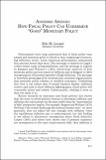Mostrar el registro sencillo del ítem
Anchors aweigh: how fiscal policy can undermine 'good' monetary policy
| dc.contributor.author | Leeper, Eric M. | |
| dc.date.accessioned | 2019-11-01T00:05:14Z | |
| dc.date.available | 2019-11-01T00:05:14Z | |
| dc.date.issued | 2011 | |
| dc.identifier.isbn | 978-956-7421-35-0 | |
| dc.identifier.uri | https://hdl.handle.net/20.500.12580/3885 | |
| dc.description | Policymakers have long understood that if fiscal policy runs amuck and monetary policy is forced to raise seigniorage revenues big inflations result. Latin American policymakers understand this outcome better than most. This message is implicit in Cagan’s (1956) initial study of hyperinflation and the message is explicit in Sargent and Wallace’s (1981) theoretical analysis of how monetary policy can lose control of inflation and in Sargent’s (1983) interpretation of historical episodes of high inflations. The message is forcefully promulgated by international economic organizations that prescribe policy reforms to troubled economies. Underlying this view is the notion that if central bankers display sufficient resolve and stick to their inflation-fighting guns fiscal policy will eventually relent and reform. Unfortunately wishing it were so does not make it so. | |
| dc.format | ||
| dc.format.extent | Sección o Parte de un Documento | |
| dc.format.medium | p. 411-453 | |
| dc.language.iso | eng | |
| dc.publisher | Banco Central de Chile | |
| dc.relation.ispartof | Series on Central Banking Analysis and Economic Policies no. 16 | |
| dc.rights | Attribution-NonCommercial-NoDerivs 3.0 Chile | * |
| dc.rights.uri | http://creativecommons.org/licenses/by-nc-nd/3.0/cl/ | * |
| dc.subject | POLÍTICA FISCAL | es_ES |
| dc.subject | POLÍTICA MONETARIA | es_ES |
| dc.subject | INFLACIÓN | es_ES |
| dc.title | Anchors aweigh: how fiscal policy can undermine 'good' monetary policy | |
| dc.type.doc | Artículo | |
| dc.file.name | BCCh-sbc-v16-p411_453 |


